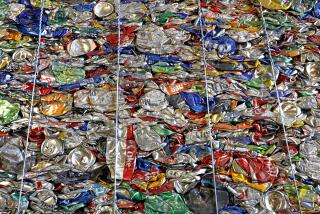New Blue Barrels Part of City Sanitation Test
- Share via
The first stage of an experiment to determine whether Los Angeles homeowners will be allowed to put virtually all recyclable trash into one barrel for pickup is almost complete.
A city program to deliver large blue plastic barrels to more than 13,000 homes scattered throughout the city is expected to be finished by the end of this week, sanitation officials said Monday.
In the San Fernando Valley, the new-style trash barrels will be delivered by Friday to 5,000 to 6,000 homes in Encino, North Hollywood, Northridge, Reseda, Sun Valley and Universal City.
Distribution of the new trash cans began in March to 800 to 1,000 homes in each of the city’s 15 council districts, kicking off the experiment to increase the efficiency of recyclable-trash collection.
Currently, in most Los Angeles neighborhoods, the city collects trash from three different containers--green bins for leaves and grass clippings, black bins for regular trash, and yellow for glass and plastics. Paper is separated on the curbside.
In areas covered by the experiment, residents can use the new blue bins to dispose of newspapers and other recyclable paper, recyclable plastic items like drink bottles, and aluminum cans. Some residents will be able to simply dump all recyclables into one can; in other neighborhoods, they will be required to separate the materials into individual compartments.
The aim is to increase efficiency, reduce scavenging and increase city revenues from recyclable materials, said John De La Rosa, program manager for the Los Angeles Sanitation Bureau’s Second Generation Recycling Program.
City officials also have another incentive: state law. The state Legislature in 1989 required California cities to reduce by 25% the amount of waste diverted to landfills by this year and 50% by 2000. Los Angeles has achieved the reduction required by this year, De La Rosa said.
City officials also hope to make more money selling recyclable materials if more householders take part. Areas where the experiment began in March have shown an increase of 100% in participation and 200% in the amount of recyclables collected, De La Rosa said.
Some residents seem pleased. The containers are “easy and convenient,” said Lotta Lira, 69, of Reseda. Without them, people might be irresponsible with their recyclables, she said.
Others, like Helene Wilcox, 72, of Northridge, withheld judgment but wondered whether the new system would work without increasing taxes.
Different versions of the new trash cans are being tested in different areas. Some neighborhoods get “single stream” containers, into which residents can dump all allowable recyclables. Other residents will use plastic bags to divide glass, plastic and paper.
Some neighborhoods receive divided containers, the right side for cans, glass containers and plastic bottles and the left for discarded paper products such as computer paper, cardboard and dry-food boxes.
Sanitation officials say they will determine by September which method is most convenient for residents and which approach works best with the Material Recovery Facilities, or MURFS, where workers separate the recyclables.
More to Read
Sign up for Essential California
The most important California stories and recommendations in your inbox every morning.
You may occasionally receive promotional content from the Los Angeles Times.













